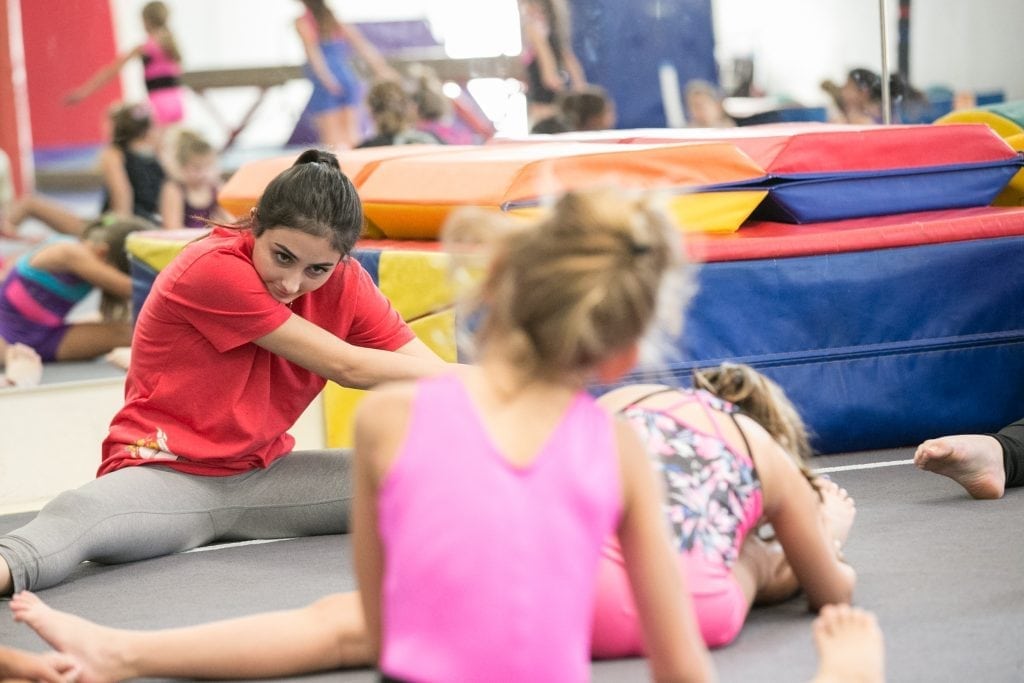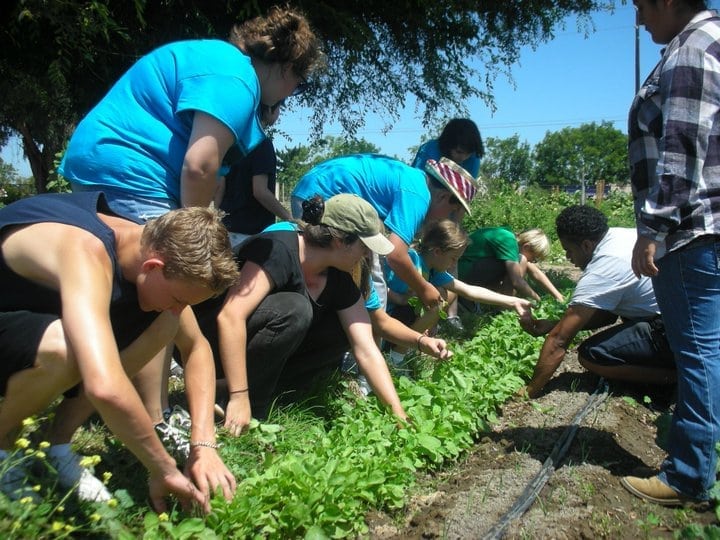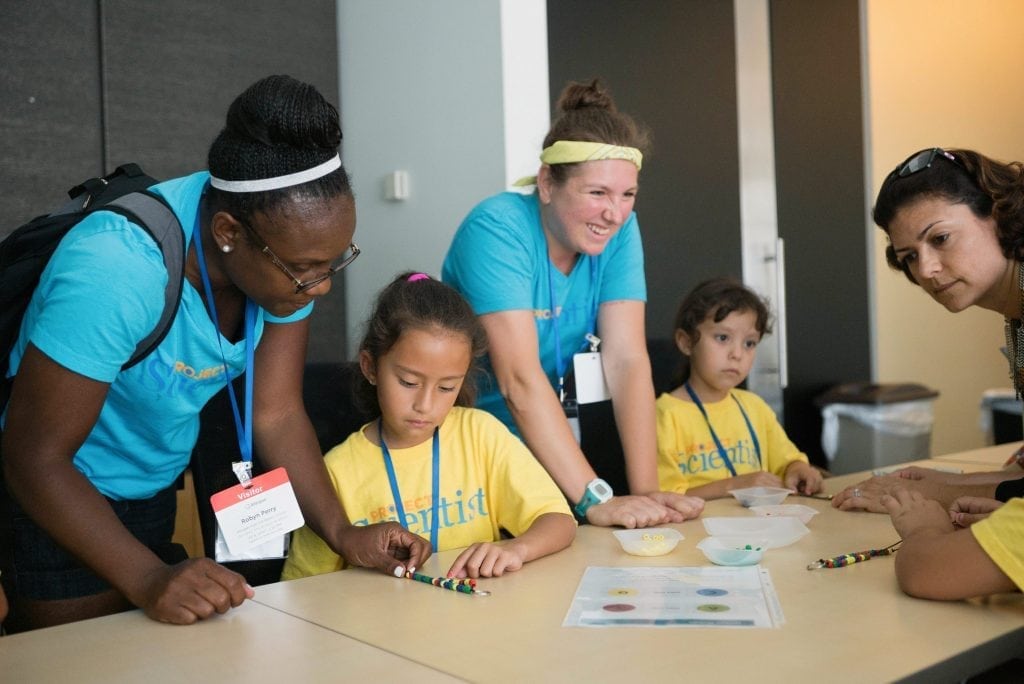
Monarchs Gym’s summer camp CIT programs help fulfill the company’s mission to foster youth development, self-awareness and leadership skills through gymnastics. PHOTO BY DESERT ROSE PHOTOGRAPHY
Not all leaders are born. Some have been cajoled into leadership roles and molded into leadership material with the help of summer camps in Los Angeles. At least that’s Sasha Karlova’s story. While the young Karlova was soft-spoken and reticent, her mentors glimpsed a spark in her that they sensed could be stoked into something more. “Leadership is not something that comes easily for me, but I have been very fortunate in my life to be encouraged to step up into leadership roles,” says Karlova, who today is the visitor experience manager for the Zimmer Children’s Museum.
When she was a teen, Karlova cut her leadership teeth in a youth program at the Zimmer. “After college, I ended up coming back to work at the Zimmer,” she says. “This organization tries to create young leaders and changers. It’s committed to getting kids involved in their communities by giving them a voice and letting them know [they] can change the world and step up and be leaders.”
Karlova’s leadership training at the Zimmer is part of the reason she speaks passionately about the museum’s summer camp counselors-in-training, or CIT, program. These CIT programs, Karlova and others say, help kids develop a sense of authority and ownership as they move more fully into – or discover for the first time – their own brand of leadership.
A Peek Around Town
At the Zimmer, summer campers from infants to age 8 spend their days exploring art and making their own. Camp counselors and junior counselors (ages 16 and older) have always overseen these campers, but a few years ago, camp organizers realized something was missing: the tweens and younger teens. Too old for camp and too young for the paid junior counselor positions, that middle group had no role.
“We had a lot of younger kids looking for volunteer experiences,” says Karlova. “It’s an interesting age because there’s so much transition going on.” The museum answered the call by creating a CIT program for ages 11-15.
Doug Lynn, director of camps for the Wilshire Boulevard Temple, gets to watch kids – particularly those involved in the temple’s summer sleepaway camps in Malibu – mature through their CIT programs. The sleepaway camps are a time for kids to disconnect from the stress of daily life, including all digital devices, and connect face-to-face with one another. “They allow kids to become the best version of themselves, to create lifelong friendships by living together in a uniquely Jewish environment,” Lynn says.
Because of this mission, campers must take a gap year between 11th and 12th grade before they can apply to become CITs. “We don’t want the CIT summer to be just another summer,” Lynn explains. “We have a very specific training program. It’s not just about being a camper anymore. It’s large group management, child development and spiritual development. It’s on-the-job training, and we want them to have the maturity level we believe they need. It’s a very selective program.”
In 2011, Meredith Madnick founded Camp Helping Hands, which has locations in Thousand Oaks and the Conejo Valley, because she was looking for a specific type of summer camp – one that focused on giving – for her daughter, who was 5½. She was coming up short. “I was just beginning to see signs and signals that she was growing up very spoiled,” Madnick says. “But just eight miles away, there were people in need, and I felt like we could be better involved in service.”
Today, Camp Helping Hands conducts service projects that benefit the Earth, people, animals and the community at large, and it uses the support of CITs – who are called Chief Aides – to do it. “We have a hybrid camper-trainee program,” Madnick says. “We buddy our Chief Aides up with our youngest campers when they start showing a capacity for wanting to do more. We allow them to lead. Some of our [hired] counselors are former Chief Aides, and this, honestly, was my whole vision.”

CITs at Camp Helping Hands work alongside younger campers on service projects for people, the Earth and animals. PHOTO COURTESY CAMP HELPING HANDS
Lena Urusova, executive director of Monarchs Gym, says the company developed a CIT program for its summer camps, located in Agoura Hills and Newbury Park, because such programs fall right in line with their mission. “Our mission is to foster youth development, self-awareness and leadership skills through the concentrated effort of coaching gymnastics,” she says. Monarchs’ CITs, usually ages 14-16, are looking for leadership experience and also need to serve volunteer hours for school. “We require about an hour to five hours a week of their commitment because we stress discipline, time management and responsibility for coming to work on time,” Urusova says.
Over at Project Scientist, a STEM-focused summer camp for girls ages 4-12, students can be found dissecting sheep brains or cow eyes with credentialed teachers. They tour companies such as JPL, Google and Microsoft and get an inside view of how to pursue a career in science, technology, engineering or math from what the program calls “Female STEM Superstars” – women working in these still-underrepresented fields. The camp’s CIT positions are actually college fellowship positions, and are filled by local college students majoring in STEM or education fields. “Our fellows serve as mentors to the girls and they work under the guidance of credentialed teachers,” says Project Scientist founder and CEO Sandy Marshall. “This is a chance for our young girls and the college students to see the [trajectory] of what it takes to pursue a STEM path. They all benefit from networking with our female STEM professionals.”
Job Description and Training
If your older kids are looking to take on some extra responsibility this summer, inquire about counselor training opportunities at their camp – or look for other camps that offer CIT programs. Keep in mind, though, that there is often a stringent application process. Your child can access camps’ CIT applications online, but that is just the beginning. “Our selections are based on the application; essays; short answers; references from coaches, teachers and rabbis and interviews,” Lynn says of Wilshire Boulevard Temple’s program.
RELATED: Our #CampReady Series
Once a student has been selected, specific CIT duties vary from camp to camp. The CITs at Monarchs Gym, for instance, are in charge of leading something – whether that’s games or a group of kids on the floor – every day. “They are under the supervision of an older counselor, but we want them to have ownership of their program,” says Urusova. “The goal is that they will be able to step up and execute, not just be in the gym in the background.”
Whatever their level of involvement, CITs are generally trained to work with younger children and eventually become camp counselors. Whether they continue on this journey is up to them, but they undergo training that can include basic safety, first-aid skills and learning to moderate disputes, listen to others, plan fun activities and support their adult counterparts.
“We train, we train, we train, we train,” says Lynn. “We spend weeks where they’re working with social workers and rabbis and camp professionals. Where they’re learning to interact with kids. We give them the educational basis to then go out and do the work.”

At Project Scientist, a STEM-focused summer camp for girls, young counselor positions are held by local college students. PHOTO COURTESY PROJECT SCIENTIST
Training is a bit less intense at Camp Helping Hands, where CITs train from 9 a.m.-3 p.m. for three days before camp begins. “We cover everything from policies and procedures to risk management and safety, how to manage behavior, communication skills, scheduling, organizing space and setting up activities,” Madnick says.
And if trouble-shooting becomes necessary, CITs know what to do. “They are never to do anything on their own,” Madnick says. “If they are in a situation where two little kids are starting to fight, they are given some tools [on how to moderate] during training, but they are supposed to contact paid staff [first] if they see something.” Ask about your specific camp’s ratio of counselors and CITs to students. In most cases, CITs are not left alone with younger children.
Ripple Effects
While summer camp programs report a fairly high ratio of CITs returning to become counselors – at least for a little while – their reach extends far beyond that role. “We want this to help them in their future,” Madnick says. “It looks really good on job resumes and helps them build job skills.”
The role of the CIT at summer camp is to learn and engage, but “it becomes so much more than that,” says Lynn. “They get to play cool older brother, older sister. It’s real bonding.”
Urusova agrees. “Adults are really good about safety and those are really good things, especially with something like gymnastics. But camp is also about having fun, and I need my young leadership team because they energize us, they know how to get things stirred up. The younger kids really look up to them.”
And while not all leaders appear outwardly dynamic, Karlova reminds us that a true leader possesses several qualities. “It’s about listening to those around you and to what the needs are,” she says. “Not being set in your ways. I feel that I’ve changed my mind a lot as a leader because I listened. When you’re a leader, it’s not just about you; it’s about your team; it’s about your community.”
CIT programs can be safe spaces for kids to take a chance and stretch their leadership wings. “Sometimes, you’ll fail and make the wrong decisions,” Karlova says. “That’s why mentors are really important – to let kids know that if you’re on your leadership journey, you are going to fail. And that’s OK.”
Cassandra Lane is managing editor of L.A. Parent. Her 10-year-old son Solomon, who has no younger siblings to boss around, is eager to become a CIT soon.


























